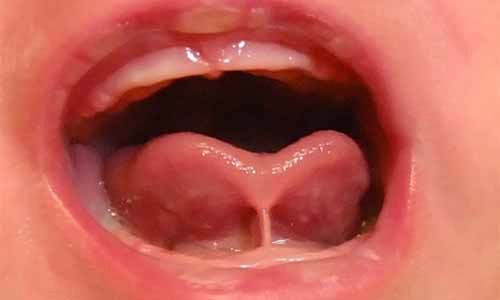Tongue Tie
What Is it?
From the Mayo Clinic: Tongue-tie (ankyloglossia [anchored tongue]) is a condition present at birth that restricts the tongue's range of motion. With tongue-tie, an unusually short, thick or tight band of tissue (lingual frenulum) tethers the bottom of the tongue's tip to the floor of the mouth, so it may interfere with breast-feeding.
It’s difficult to improve on a Mayo Clinic definition, and in our experience, this is also a very good description of conditions presenting in a surprising number of infants and small children that become our patients. If unable to move the tongue or keep it in the right position, the baby might chew instead of suck on the nipple. This can cause significant nipple pain and interfere with a baby's ability to get breast milk. Ultimately, poor breast-feeding can lead to inadequate nutrition and failure to thrive.
There has been much discussion and disagreement in the medical community surrounding Tongue-, Lip-, Cheek- and Buckle-Tie and their contribution to significant developmental issues in infants and children. But as the medical understanding of tongue-tie has grown, it has become associated with many developmental issues in children. Left untreated, it can lead to speech impediments, trouble eating and swallowing, sleep issues such as mouth-breathing and sleep apnea, and can contribute to poor oral hygiene. In some cases, very strong ties can interfere with dental development between the two front teeth on the bottom row. In reality, the list of issues associated with tongue is long and growing, as medical research continues to reveal the depth and breadth of the problem.
Mothers of infants with tongue tie can also suffer from a variety of issues, both physical and emotional. Because infants with tongue tie can have difficulty in forming a successful suction/sucking action, the struggle to breastfeed can leave both the baby and the mother with discomfort, a lack of confidence, and can even affect the bond between mother and child. Over-engorging, blocked ducts/glands and mastitis can also result for the mother.
Treatment Options
The good news is that there is a growing medical acknowledged that an oral structural defect which restricts the normal movement of the tongue can cause a range of difficulties. More importantly, treatment/correction can often be achieved by an operation that has been described as simple, brief and devoid of complications. There are several options for the correction of a tongue-tied frenum, including snipping the frenum in infants, laser surgery or conventional surgery in children over 6 and even the revision of the frenulum in older children and adults through electrocautery, laser or conventional surgery with general or local anesthetic. The age of the patient, as well as the severity and specific presentation of the tongue-tie will determine the appropriate treatment method.
MFP Perspective
Tongue-tie can present a serious and significant obstacle to infants/children and parents thriving and should be treated as soon as possible/practicable. Parents with tongue-tie concerns for their children should actively seek information and answers on the subject. Talk with us about it. If you suspect tongue-tie, let’s evaluate your child for tongue-tie and talk about treatment options, if appropriate. In our experience, treatment has provided remarkable progress and positive change in the lives of children, mothers and their families.
- Impact on milk supply
- Termination of breastfeeding
- The baby failing to thrive
- Poor bonding between baby and mother
- Sleep deprivation
- Problems with introducing solids
- Pain
- Nipple damage: bleeding, blanching or distortion of the nipples
- Mastitis, nipple thrush or blocked ducts
- Severe pain with latch or losing latch
- Sleep deprivation caused by the baby being unsettled
- Depression or a sense of failure


